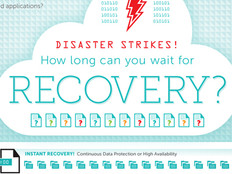4 Tips to Safeguard Your Data from Natural Disasters
2017 was the costliest year on record for natural disasters in the United States, according to the National Oceanic and Atmospheric Administration, with 16 events causing more than $1 billion each in damage. Combined, the hurricanes, floods, wildfires and other events caused $306.2 billion in damage, shattering the previous high of $214.8 billion in 2005.
Natural disasters have cost the United States more than $1.5 trillion since 1980, and scientists predict that the future will include more extreme weather as the climate changes and the planet warms. Over a 37-year period, 20 percent of the cost has been incurred in the last year alone.
While the main focus in the aftermath of these catastrophes is their impact on health, the economy and the environment — and rightfully so — they also should prompt every company and organization to examine how well their computer systems and data are protected if the worst happens.
The stakes are high. According to the Federal Emergency Management Agency, 40 percent of businesses do not reopen after a disaster. And yet, a 2012 study by Travelers Insurance found that 48 percent of small businesses lack a business continuity plan.
In our digital age, the cost of downtime has never been more daunting. A 2015 survey of 400 mid- to large-sized companies by analyst firm IHS found that outages caused by weather events, cyberattacks and equipment failures cost North American firms $700 billion a year in lost revenue and employee productivity. Many small businesses never recover.
Natural disasters take lives, destroy property and affect millions of people, even if they’re not direct victims. The 1-in-1,000-year flood from Hurricane Harvey came within a nerve-wracking fraction of an inch of flooding my brother’s family home in Katy, Texas, and swamped his company office, taking it offline for months. Friends of mine lost property and businesses in the Northern California wildfires.
It’s human nature to think that just because something bad hasn’t happened before, it won’t in the future. But at a time when natural disasters are increasing in number and intensity, businesses of all sizes must imagine the dangers of being taken offline and be prepared.
Here are four steps that companies of all sizes should take to safeguard themselves:
SIGN UP: Get more news from the BizTech newsletter in your inbox every two weeks!
1. Stay Up and Running with a Business Continuity Plan
The continuity plan details the processes a company should follow in case of a major disruption, whether caused by a fire, flood, cyberattack, power failure or human error. It’s a sensible, proactive way to bring predictability to an inherently unpredictable situation and get the business back up and running as soon as possible. Don’t run a business without one.
2. Use the Cloud to Store Data Off-site
Cloud computing offers many benefits: lower costs, greater scalability and increased flexibility, to name a few. No wonder the public cloud market was projected to grow 18.5 percent last year, from $219.6 billion to $260.2 billion, according to Gartner.
Another advantage of the cloud is how it helps with business continuity. The cloud means organizations don’t have to keep as much, or sometimes any, of their data on-premises. Cloud services can also provide backup and offsite replicas of data for those that do.
Despite all that, there are still “cloud laggards” out there. At a time when data faces so many threats, a wait-and-see approach is unwise. The cloud is your friend, folks.
3. Consider Geographic Redundancy to Protect Data
Large cloud providers ensure availability of business-critical data by replicating it to a secondary data center region far away from the primary one. So, if an unforeseen event takes the primary location offline, you’re still protected.
Keep in mind that some providers charge extra for this service. Businesses should weigh the costs and benefits, but they should opt in if it’s financially feasible.
4. Inventory Your Data Across Systems
Many organizations are all over the place with their data storage. Key business information may reside on disparate databases on siloed systems they have added through the years. Or quite often, it could be on someone’s laptop or a desktop machine or stranded server tucked away in the corner of the office.
It sounds elementary, but it’s important that businesses get a handle on what data they have and where it is located, so they can understand what data to protect.
The series of natural disasters in 2017 was a wake-up call that anything can happen, and that lacking a resilience strategy leaves a business exposed to potentially crippling consequences.
Preparation, before disaster strikes, is the best defense.









